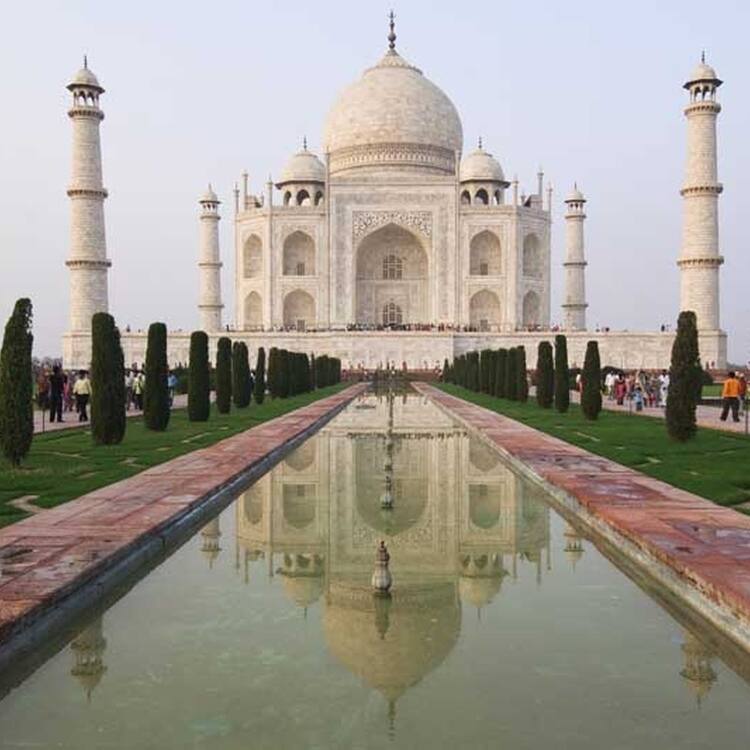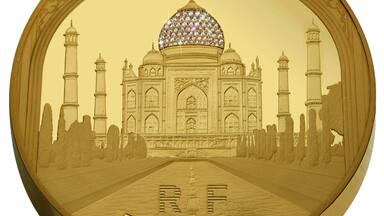Taj Mahal
Taj Mahal
An immense mausoleum of white marble, built in Agra between 1631 and 1648 by order of the Mughal emperor Shah Jahan in memory of his favourite wife, the Taj Mahal is the jewel of Muslim art in India and one of the universally admired masterpieces of the world's heritage.
Description is available under license CC-BY-SA IGO 3.0
Le Taj Mahal
Immense mausolée funéraire de marbre blanc édifiée entre 1631 et 1648 à Agra sur l'ordre de l'empereur moghol Shah Jahan pour perpétuer le souvenir de son épouse favorite, le Taj Mahal, joyau le plus parfait de l'art musulman en Inde, est l'un des chefs-d'œuvre universellement admirés du patrimoine de l'humanité.
Description is available under license CC-BY-SA IGO 3.0
تاج محل
إنّ تاج محل هو ضريح جنائزي هائل شُيّد من الرخام الأبيض بين عامي 1631 و1648 في أغرا بناءً على أوامر الإمبراطور المغولي شاه جهان بهدف تخليد ذكرى زوجته المفضّلة. ويشكّل تاج محل الذي يُعتبر أفضل جوهرة في الفن الإسلامي في الهند إحدى أبرز تُحف التراث البشري التي هي محطّ إعجاب العالم بأسره.
source: UNESCO/CPE
Description is available under license CC-BY-SA IGO 3.0
泰姬陵
泰姬陵是一座由白色大理石建成的巨大陵墓清真寺,是莫卧儿皇帝沙贾汗(Shah Jahan)为纪念他心爱的妃子于1631年至1648年在阿格拉修建的。泰姬陵是印度穆斯林艺术的瑰宝奇葩,是世界遗产中令世人赞叹的经典杰作之一。
source: UNESCO/CPE
Description is available under license CC-BY-SA IGO 3.0
Мавзолей Тадж-Махал (город Агра)
Великолепный мавзолей из белого мрамора был возведен в Агре между 1631 и 1648 гг. по приказу могольского императора Шах-Джахана в память о его любимой жене. Тадж-Махал – это жемчужина мусульманского искусства в Индии и один из всеми признанных шедевров всемирного наследия.
source: UNESCO/CPE
Description is available under license CC-BY-SA IGO 3.0
Taj Mahal
Edificado entre 1631 y 1648 por orden del emperador mogol Shah Jahan para perpetuar la memoria de su esposa favorita, este grandioso mausoleo de mármol blanco es el más precioso joyel del arte musulmán en la India y una de las obras maestras universalmente admiradas del patrimonio cultural de la humanidad.
source: UNESCO/CPE
Description is available under license CC-BY-SA IGO 3.0
タージ・マハル
1632年から22年の歳月をかけて、アグラの町に建てられた霊廟。ムガール帝国第5代のシャー・ジャハーンが、亡くなった最愛の妃ムムターズ・マハルのために建立した。中心のドームの高さは58m、周辺に4本のミナレット(尖塔)がそびえている。外観はペルシア風だが、内部はインド的な造りで、世界的にも最も美しいイスラーム建築の傑作といわれている。source: NFUAJ
Taj Mahal
Dit gigantische mausoleum – opgetrokken uit wit marmer – werd tussen 1631 en 1648 gebouwd in Agra in opdracht van de Mogolse Keizer Shah Jahan, ter nagedachtenis aan zijn favoriete echtgenote Mumtaz Mahal. Het is het kroonstuk van de islamitische kunst in India en wordt universeel gezien als één van de meesterstukken op de Werelderfgoedlijst. Het mausoleum is gebouwd op de rechteroever van de (rivier) Yamuna en staat in een geweldige Mogolse tuin die bijna 17 hectaren beslaat. De Taj Mahal wordt beschouwd als het grootste architectonische werk binnen de Indo-islamitische cultuur. Het reliëfwerk in het marmer en de ingelegde edel- en halfedelstenen maken het een buitengewoon monument.
Source: unesco.nl
ताज महल
मुगल बादशाह शाहजहाँ के आदेश से अपनी प्रियतमा पत्नी की याद में 1631 और 1648 के बीच आगरा में सफेद संगमरमर का एक विशाल मकबरा बनाया गया, ताजमहल भारत में मुस्लिम कला की उत्कृष्ट कृति है और विश्व विरासत में सार्वभौमिक रूप से प्रशंसित उत्कृष्ट कृतियों में से एक है।
Source: India
Outstanding Universal Value
Brief synthesis
The Taj Mahal is located on the right bank of the Yamuna River in a vast Mughal garden that encompasses nearly 17 hectares, in the Agra District in Uttar Pradesh. It was built by Mughal Emperor Shah Jahan in memory of his wife Mumtaz Mahal with construction starting in 1632 AD and completed in 1648 AD, with the mosque, the guest house and the main gateway on the south, the outer courtyard and its cloisters were added subsequently and completed in 1653 AD. The existence of several historical and Quaranic inscriptions in Arabic script have facilitated setting the chronology of Taj Mahal. For its construction, masons, stone-cutters, inlayers, carvers, painters, calligraphers, dome builders and other artisans were requisitioned from the whole of the empire and also from the Central Asia and Iran. Ustad-Ahmad Lahori was the main architect of the Taj Mahal.
The Taj Mahal is considered to be the greatest architectural achievement in the whole range of Indo-Islamic architecture. Its recognised architectonic beauty has a rhythmic combination of solids and voids, concave and convex and light shadow; such as arches and domes further increases the aesthetic aspect. The colour combination of lush green scape reddish pathway and blue sky over it show cases the monument in ever changing tints and moods. The relief work in marble and inlay with precious and semi precious stones make it a monument apart.
The uniqueness of Taj Mahal lies in some truly remarkable innovations carried out by the horticulture planners and architects of Shah Jahan. One such genius planning is the placing of tomb at one end of the quadripartite garden rather than in the exact centre, which added rich depth and perspective to the distant view of the monument. It is also, one of the best examples of raised tomb variety. The tomb is further raised on a square platform with the four sides of the octagonal base of the minarets extended beyond the square at the corners. The top of the platform is reached through a lateral flight of steps provided in the centre of the southern side. The ground plan of the Taj Mahal is in perfect balance of composition, the octagonal tomb chamber in the centre, encompassed by the portal halls and the four corner rooms. The plan is repeated on the upper floor. The exterior of the tomb is square in plan, with chamfered corners. The large double storied domed chamber, which houses the cenotaphs of Mumtaz Mahal and Shah Jahan, is a perfect octagon in plan. The exquisite octagonal marble lattice screen encircling both cenotaphs is a piece of superb workmanship. It is highly polished and richly decorated with inlay work. The borders of the frames are inlaid with precious stones representing flowers executed with wonderful perfection. The hues and the shades of the stones used to make the leaves and the flowers appear almost real. The cenotaph of Mumtaz Mahal is in perfect centre of the tomb chamber, placed on a rectangular platform decorated with inlaid flower plant motifs. The cenotaph of Shah Jahan is greater than Mumtaz Mahal and installed more than thirty years later by the side of the latter on its west. The upper cenotaphs are only illusory and the real graves are in the lower tomb chamber (crypt), a practice adopted in the imperial Mughal tombs.
The four free-standing minarets at the corners of the platform added a hitherto unknown dimension to the Mughal architecture. The four minarets provide not only a kind of spatial reference to the monument but also give a three dimensional effect to the edifice.
The most impressive in the Taj Mahal complex next to the tomb, is the main gate which stands majestically in the centre of the southern wall of the forecourt. The gate is flanked on the north front by double arcade galleries. The garden in front of the galleries is subdivided into four quarters by two main walk-ways and each quarters in turn subdivided by the narrower cross-axial walkways, on the Timurid-Persian scheme of the walled in garden. The enclosure walls on the east and west have a pavilion at the centre.
The Taj Mahal is a perfect symmetrical planned building, with an emphasis of bilateral symmetry along a central axis on which the main features are placed. The building material used is brick-in-lime mortar veneered with red sandstone and marble and inlay work of precious/semi precious stones. The mosque and the guest house in the Taj Mahal complex are built of red sandstone in contrast to the marble tomb in the centre. Both the buildings have a large platform over the terrace at their front. Both the mosque and the guest house are the identical structures. They have an oblong massive prayer hall consist of three vaulted bays arranged in a row with central dominant portal. The frame of the portal arches and the spandrels are veneered in white marble. The spandrels are filled with flowery arabesques of stone intarsia and the arches bordered with rope molding.
Criterion (i): Taj Mahal represents the finest architectural and artistic achievement through perfect harmony and excellent craftsmanship in a whole range of Indo-Islamic sepulchral architecture. It is a masterpiece of architectural style in conception, treatment and execution and has unique aesthetic qualities in balance, symmetry and harmonious blending of various elements.
Integrity
Integrity is maintained in the intactness of tomb, mosque, guest house, main gate and the whole Taj Mahal complex. The physical fabric is in good condition and structural stability, nature of foundation, verticality of the minarets and other constructional aspects of Taj Mahal have been studied and continue to be monitored. To control the impact of deterioration due for atmospheric pollutants, an air control monitoring station is installed to constantly monitor air quality and control decay factors as they arise. To ensure the protection of the setting, the adequate management and enforcement of regulations in the extended buffer zone is needed. In addition, future development for tourist facilities will need to ensure that the functional and visual integrity of the property is maintained, particularly in the relationship with the Agra Fort.
Authenticity
The tomb, mosque, guest house, main gate and the overall Taj Mahal complex have maintained the conditions of authenticity at the time of inscription. Although an important amount of repairs and conservation works have been carried out right from the British period in India these have not compromised to the original qualities of the buildings. Future conservation work will need to follow guidelines that ensure that qualities such as form and design continue to be preserved.
Protection and management requirements
The management of Taj Mahal complex is carried out by the Archaeological Survey of India and the legal protection of the monument and the control over the regulated area around the monument is through the various legislative and regulatory frameworks that have been established, including the Ancient Monument and Archaeological Sites and Remains Act 1958 and Rules 1959 Ancient Monuments and Archaeological Sites and Remains (Amendment and Validation); which is adequate to the overall administration of the property and buffer areas. Additional supplementary laws ensure the protection of the property in terms of development in the surroundings.
An area of 10,400 sq km around the Taj Mahal is defined to protect the monument from pollution. The Supreme Court of India in December, 1996, delivered a ruling banning use of coal/coke in industries located in the Taj Trapezium Zone (TTZ) and switching over to natural gas or relocating them outside the TTZ. The TTZ comprises of 40 protected monuments including three World Heritage Sites - Taj Mahal, Agra Fort and Fatehpur Sikri.
The fund provided by the federal government is adequate for the buffer areas. The fund provided by the federal government is adequate for the overall conservation, preservation and maintenance of the complex to supervise activities at the site under the guidance of the Superintending Archaeologist of the Agra Circle. The implementation of an Integrated Management plan is necessary to ensure that the property maintains the existing conditions, particularly in the light of significant pressures derived from visitation that will need to be adequately managed. The Management plan should also prescribe adequate guidelines for proposed infrastructure development and establish a comprehensive Public Use plan.

 View photos from OUR PLACE the World Heritage collection
View photos from OUR PLACE the World Heritage collection
